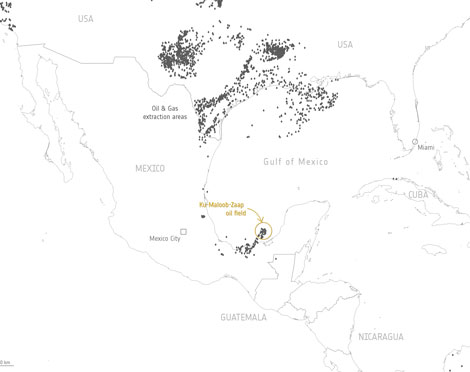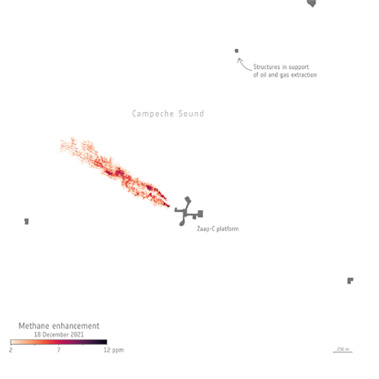- News
- WorldView-3 helps to track off...
WorldView-3 helps to track offshore methane plumes from oil and gas
06 Jul 2022
Scientists have used Earth observation data to reveal enormous methane plumes spilling out from an offshore oil and gas production rig in the Gulf of Mexico.
This represents a significant breakthrough in the monitoring of industrial methane emissions from space.
The analysis – led by scientists from the Universitat Politècnica de València – drew on data from the WorldView-3 satellite, which were delivered on a free basis via ESA’s Third Party Missions (TPM) programme. It also used imagery collected by the US-led Landsat-8 mission.
Methane is less abundant in the atmosphere than carbon dioxide, but it is a more powerful heat-trapping gas. As a result, scientists believe that addressing methane leaks from human activities could be key for the global drive to tackle climate change.
Using satellites to monitor methane emissions from offshore oil and gas infrastructure could make important contributions to these mitigation efforts.
However, despite the rapid development of space-based methane plume detection methods over land, it remains difficult to use remote sensing missions to monitor these emissions over sea.
Methane detection from space involves the use of shortwave infrared wavelengths. But the high absorption of this radiation by water limits the amount of light bouncing back to the satellite’s sensor, making it problematic to distinguish methane emissions.
As part of the analysis, the researchers overcame this challenge by using an imaging mode in which the angular configuration of the satellite is adjusted.
The study focused on oil and gas production activities off the coast of the Mexican state of Campeche, in one of the country’s major oil fields. The initial aim of the analysis was to explore the feasibility of using WorldView-3 to monitor offshore methane plumes.

Launched in 2014, WorldView-3 is a multispectral Earth observing satellite that is owned and operated by US space technology firm Maxar. ESA added the mission to its TPM programme in 2016, which involves an agreement with EUSI (European Space Imaging) to deliver the data.

The satellite’s instrument – called the WorldView-110 camera – captures images in a number of spectral ranges, including eight bands of the short-wave infrared range.
These data have a high resolution of 3.7 m and a high signal-to-noise ratio, which make it a powerful mission for methane mapping.
WorldView-3 and Landsat 8 enabled the researchers to detect large plumes emanating from within the study area.
The researchers identified a platform known as Zaap-C as being responsible for the plumes, which were emitted from two boom-type flares linked to oil and gas production and separation.
An analysis process was then developed by which the emissions detected by WorldView-3 and Landsat-8 could be quantified, to understand the amount of methane released by the platform.
The presence of the plumes was verified through comparisons with imagery collected by other Earth observation missions.
In addition, the appearance of these emissions was cross-referenced with flaring activity on the platform, by using NASA's Fire Information for Resource Management System.
The researchers reported a 17-day ultra-emission event in December 2021, which resulted in the release of some 40,000 tonnes of methane from the platform into the atmosphere. This was equivalent to around 3% of Mexico’s annual oil and gas emissions.
Analysis of the site’s flaring activity showed that the emissions were likely related to abnormal process conditions, indicating that the event could be a one-time incident caused by malfunctions or issues with equipment.
The project demonstrates how satellite data can be used to produce actionable information about methane plumes from offshore infrastructure, which could help to inform strategies to reduce these emissions.
The results of the project were recently published in Environmental Science and Technology Letters.
The study received funding from the EO Science for Society component of ESA’s FutureEO Programme and the ESA Living Planet Fellowship.
The Earth Online editorial team is always looking for new Success Stories to highlight how Earth observation data benefit society and the environment. If you have a proposal for a potential story related to your work with ESA Third Party Missions data, please contact the Earth Online editors at: contentmatters4earthonline@ejr-quartz.com
References:
Satellites Detect a Methane Ultra-emission Event from an Offshore Platform in the Gulf of Mexico. Itziar Irakulis-Loitxate, Javier Gorroño, Daniel Zavala-Araiza, and Luis Guanter. Environmental Science & Technology Letters 2022 9 (6), 520-525; DOI: 10.1021/acs.estlett.2c00225